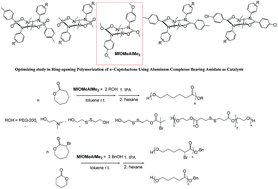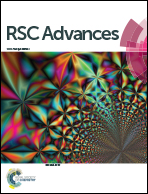Optimizing ring-opening polymerization of ε-caprolactone by using aluminum complexes bearing amide as catalysts and their application in synthesizing poly-ε-caprolactone with special initiators and other polycycloesters†
Abstract
A series of aluminum complexes bearing amidate ligands, including acylamide, sulfonamide, and aryl carbamate, was synthesized. In addition, the optimization of ring-opening polymerization of ε-caprolactone by using these aluminum complexes as catalysts was studied. Polymerization results revealed that steric bulky groups in anilinyl groups decreased the catalytic activity of aluminum sulfonamide complexes but increased that of aluminum–acylamide complexes. Compared with other complexes bearing N-(4-methoxyphenyl) acylamidate and N-(4-methoxyphenyl) p-tolylsulfonamidate, an aluminum complex (MfOMeAlMe2) bearing methyl (4-methoxyphenyl)carbamate had the highest catalytic activity with an ideal molecular weight control and narrow polydispersity index (PDI). Other poly-ε-caprolactones with special end chains, such as PEG-200, 2-dimethylaminoethanol, bis(2-hydroxyethyl) disulfide, 2-((2-hydroxyethyl)disulfanyl)ethyl 2-bromo-2-methylpropanoate, and PEG-polyester-bearing disulfide group, were successfully synthesized using MfOMeAlMe2 as the catalyst. The polymerization of δ-valerolactone and 2-bromo-ε-caprolactone by using BnOH as an initiator and MfOMeAlMe2 as the catalyst resulted in poly-δ-valerolactone and poly-2-bromo-ε-caprolactone, respectively, with a precise molecular weight and a narrow PDI as well as poly-ε-caprolactones.


 Please wait while we load your content...
Please wait while we load your content...